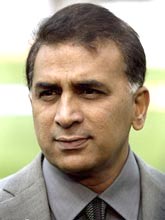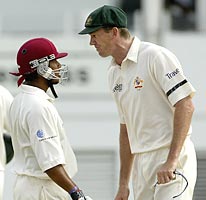Home > Cricket > Columns > Daniel Laidlaw
Sunny's sledge on sportsmanship
August 07, 2003
In the days when the adage "it's not cricket" had relevance, players would indicate if the ball had bounced before they caught it, applaud one another's milestones, and make sporting declarations for the good of the game. Today, players want to win at all costs, appeal when they know it's not out, don't walk when they've nicked it, and ignore each other's milestones. Worst of all, they sledge every second over.
That, at least, is the view of former Indian great Sunil Gavaskar, as recently expressed at the MCC's Colin Cowdrey memorial lecture. Sportsmanship, Gavaskar claimed, has "gone for a six".
 | Express your opinion |  | |
|
While the examples Gavaskar drew upon to illustrate his point about the loss of sportsmanship hurting cricket were broad, he appeared to have a specific if unnamed object of criticism in mind -- the Australians. In an obvious reference to Australia, Gavaskar said that while "there are perhaps not even 15 (players) who indulge in this verbal abuse and intimidation... unfortunately most of these belong to a champion side and it makes others believe that it's the only way to play winning cricket".
 Gavaskar's views on sledging were not shared by those with a closer association to the modern game. "I have played against those guys, and coached most of them, and I don't see it as a problem," said former Australian coach Geoff Marsh. Sourav Ganguly also thought Australia's sledging was overplayed, saying that while "I don't totally disagree with Gavaskar... it [sledging] is a minor issue which should not be blown out of proportion".
Gavaskar's views on sledging were not shared by those with a closer association to the modern game. "I have played against those guys, and coached most of them, and I don't see it as a problem," said former Australian coach Geoff Marsh. Sourav Ganguly also thought Australia's sledging was overplayed, saying that while "I don't totally disagree with Gavaskar... it [sledging] is a minor issue which should not be blown out of proportion".
Questioning the need for sledging, Gavaskar posed the question: "Did Bradman's all-conquering side of 1948 practise these tactics? I don't know, though I know for certain that Clive Lloyd's champions of the 1970s and 1980s never uttered a word on the field to an opponent. A glare and raised eyebrow were enough to put the scare in you!"
The West Indies may have bowled 70 overs a day and physically intimidated opponents with short-pitched bowling, but they didn't sledge, therefore they were good sportsmen. This rose-coloured view of history will in all likelihood also come to apply to the current Australian team when their time has passed. For the time being, though, they are still top of the tree and thus open to criticism -- and it is for sledging alone that Australia can be criticised.
As others have pointed out, Colin Croft once deliberately barged into an umpire and Michael Holding kicked down the stumps in frustration, petulance which, with today's close-ups, replays and match referees, would become an international incident rather than just a memorable black-and-white photograph. Gavaskar's confinement of the definition of poor sportsmanship largely to verbal abuse appears self-serving.
One of the reasons sledging is such a hot topic, like the West Indies' short-pitched bowling tactics of yesteryear, is because the team most responsible for it is so dominant. Success is resented as much as it is celebrated and does eventually get boring. The media must grow tired of writing the same story and, as Geoff Marsh noted, start looking for reasons to criticise.
This is not to say that legitimate reasons do not exist -- they do, and despite Marsh's protest to the contrary, there is much that Australia could do to improve its behaviour, which is currently hurting its brand, according to Cricket Australia CEO James Sutherland. But it must be recognised that a successful team will never be considered perfect during its period of dominance. That only happens afterwards.
While dominant teams do win a large following because of their success, they also attract widespread loathing from those who do not jump on the bandwagon. Manchester United is a case in point, as are American baseball's New York Yankees. It is not known how opposition supporters felt about Michael Jordan's Chicago Bulls, but then Jordan was said to be the Bradman of his sport, and as we've seen, Bradman's 1948 team does not inspire too much criticism.
 Unfortunately, justified criticism for sledging overlooks the fact that Australia's overall contribution to the game has been overwhelmingly positive. Apart from the trend-setting manner in which they play, Australia's contribution to cricket through its academies, coaches and the like is profound. None of these teach sledging, as far as is known.
Unfortunately, justified criticism for sledging overlooks the fact that Australia's overall contribution to the game has been overwhelmingly positive. Apart from the trend-setting manner in which they play, Australia's contribution to cricket through its academies, coaches and the like is profound. None of these teach sledging, as far as is known.
In his address, Gavaskar acknowledged with pity that the adage "it's not cricket" is no longer valid. "In the modern world of commercialisation of the game and the advent of satellite television and the motto of winning at all costs, sportsmanship has gone for a six," he said. Assuming that to be true, how then can the blame for bad sportsmanship at the same time be shifted to a handful of individuals?
Steve Waugh may receive credit for many things, but commercialisation, satellite TV and a "win at all costs" attitude were not his inventions and are not unique to cricket. Gavaskar ruefully recognises that cricket reflects society at large, but still argues that it should retain values which are not to be found in the influences that affect and shape it.
In a broad sense, how can the game not fall into line with the physical, financial, and moral realities around it? If it did -- for example, if players did not wear helmets, were poorly paid, and did not value winning as much as enjoying the contest -- then cricket today would be an anachronism.
There is a compelling argument that holds that cricket's appeal lies in its uniqueness, and that its tradition and its values should stand the test of time and transcend the world around it. One has to ask, though, whether it would not lose some relevance and thus popularity if, while remaining unique, it was not representative of its times. The reinvigoration of the game that stemmed from the modernising influence of World Series Cricket, responsible for many of the features of today's game that we take for granted, suggests that it would.
Of course, many of Gavaskar's claims about today's standards are either dubious or simply incorrect. In condemning sledging, he unfortunately ignores the many sporting gestures still present in cricket today, and does the modern cricketer a disservice.
By apparently regarding sledging and acts of good sportsmanship as mutually exclusive, Gavaskar is forced to ignore evidence that does not suit his argument -- like the Australians', and others', routine applause for their opponents reaching milestones (something Gavaskar wrongly claims is a rarity), batsmen walking (Gilchrist, in a select band of two with Lara), acknowledgement of bump balls, and sundry goodwill gestures that existed in his time and continue today, like Brett Lee coaching Bangladesh's fast bowlers, to cite just one recent example.
Gavaskar also advanced the alarming notion that perhaps producers should not show players sledging, as if close-ups of the reality of the action are bad for the game, rather than compelling viewing. There is a point to be made here, but Gavaskar did not touch upon it: maybe sledging was less publicised in the past because today's explicit style of TV coverage did not exist?
While cricket boards and the like are forever concerned about "image", it is such invasive coverage that has helped make cricket a better sport to watch. No more are we subjected to dreary wide-angle shots or spend half the day watching "batsmen's arses", as Kerry Packer put it in Gideon Haigh's The Cricket War.
In offering his solutions to combat sledging, Gavaskar revealed that "the problem also is mainly due to the fact that those at the receiving end of the abuse feel that they will be called wimps if they report it to the umpires or the match referee". Just whose fault is that, then? If some players are afraid to report sledging for fear of being called wimps, then that's exactly what they are. Graeme Smith had no such fears when he went public on Australia's sledging in a magazine interview last year. If being branded a wimp is the price to pay for cleaning up the game and enduring less sledging in the future, so what?
Gavaskar's lecture romanticised the past while being unduly harsh on the way the modern game is played. It would be foolish to pretend that cricket does not have many problems, sledging numbering among them, but it is also under-recognised that cricket today is probably as exciting as it has ever been and that Australia deserve significant credit for that, sledging or no sledging. Unfortunately, that may only be fully appreciated when today's greats are at an age to deliver lectures on how much more sportsmanship existed in their era.